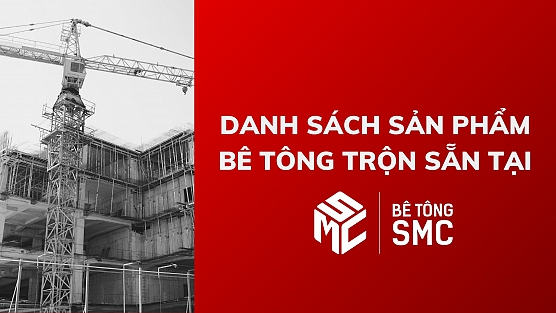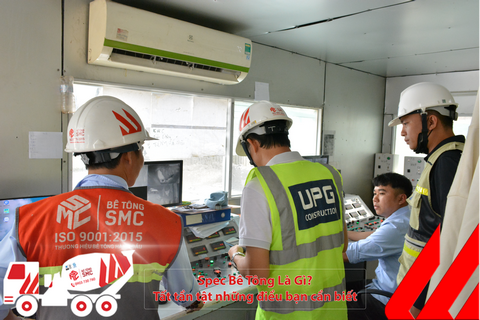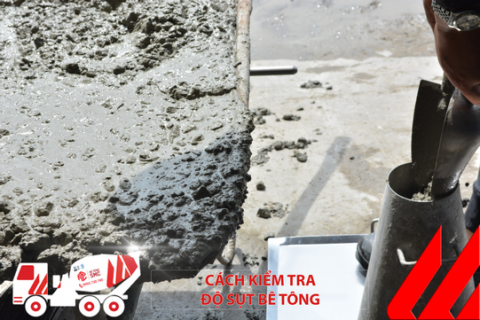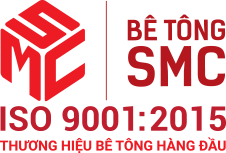Frequently asked Questions
Concrete engineering advice
Business contact
The Applications of High-Strength Concrete
What is high-strength concrete? Is high-strength concrete truly effective in construction due to its flexibility and excellent load-bearing capacity? Let SMC clarify these questions in the article below!1. Identifying High-Strength Concrete
High-strength concrete is a special type of concrete known for its superior compressive strength, with an index up to 4 to 6 times that of ordinary concrete.With a compressive strength at 28 days of greater than 60 MPa (for cylindrical specimens with D = 15cm and H = 30cm), and compressive strength after 24 hours of greater than or equal to 35 MPa.
High-strength concrete is a special type of material created from a combination of cement, optimized aggregate system, superplasticizers, and active additives. This characteristic allows it to replace some traditional materials such as steel, iron, etc., in creating products for construction projects.
Products made from high-strength concrete often have slender proportions, high aesthetic appeal, and especially competitive prices compared to existing products on the market.
2. Advantages and Disadvantages of Using High-Strength Concrete
Hopefully, the information above has helped you understand more about high-strength concrete. To gain more perspectives, let's go through some advantages and disadvantages of using this material with SMC.2.1. Advantages of High-Strength Concrete in Construction
There's no debate about its superior waterproofing and frost resistance compared to ordinary concrete when it has excellent compressive strength. Additionally, its resistance to seawater corrosion is excellent, making it commonly used in building seaports and maritime projects, as noted by experts.The use of high-strength concrete in factories reduces the size of the foundation due to the reduced material volume from using special aggregates, achieving high quality. Besides, it can increase the span length of beams or reduce the number of support columns, helping investors save on construction costs.
Moreover, using this material not only supports extending the lifespan of construction projects but also brings high aesthetic value to the structure.
Furthermore, using high-strength concrete reduces the cross-section of columns and beams, centrifugal casting equipment, vibration, and factory floor space. Consequently, it significantly helps investors save costs by reducing the need for various construction machinery.
2.2. Disadvantages of Using High-Strength Concrete
High-strength concrete does not have too many disadvantages; however, it requires technical skills and adherence to specific standards to avoid issues like stickiness and difficulty in handling. Compared to high-strength concrete, ordinary concrete is often more feasible because its components are mixed with more precision and have proper viscosity.3. How Many Types of High-Strength Concrete Are There?
In terms of types, high-strength concrete is produced according to the following main criteria:1. Compressive strength: For this type, the compressive strength of specimens is measured at 28 days. This will include:
- Types with compressive strength ranging from 20-25 MPa.
- Types with compressive strength ranging from 30-50 MPa.
- Types with compressive strength ranging from 60-80 MPa.
- Types with ultra-high compressive strength ranging from 100-150 MPa.
Classified according to material composition, concrete will include types such as:
Types that do not use silica fume but use ash. This type has high ductility, high strength with compressive strength reaching 60 MPa.
Concrete types using silica fume accounting for 5 – 15%. This type usually has compressive strength reaching up to 100 MPa.
- Concrete types reinforced with metal fibers with the highest mechanical ductility:
- Types with compressive strength ranging from 20-25 MPa.
- Types with compressive strength ranging from 30-50 MPa.
- Types with compressive strength ranging from 60-80 MPa.
- Types with ultra-high compressive strength ranging from 100-150 MPa.
4. SMC Concrete - Leading Concrete Brand
SMC Concrete Company has established itself as a leading concrete supplier with guaranteed quality and progress. At SMC, we commit to providing customers with superior quality and service.
By providing a variety of concrete grades suitable for all projects and using modern production lines, the company ensures that its concrete products are manufactured using advanced technology.
Moreover, concrete pumping services at SMC are always performed with specialized and modern vehicles, ensuring convenience and efficiency for customers.
Furthermore, the experienced and highly skilled staff at SMC Concrete ensures that the process of supplying products and services is carried out professionally and reliably.
Choose SMC Concrete for high-quality concrete products that comply with international standards ISO 9001:2015, ensuring stability and durability on all projects.
Other news
Currently, ready-mix concrete is a top choice for many construction projects—both large and small—thanks to its convenience, consistent quality, and high construction efficiency. With extensive experience supplying commercial concrete for numerous key projects in the Southern region, SMC proudly offers a diverse range of ready-mix concrete products to meet the technical requirements of every type of construction.
A Comprehensive Guide to Concrete Specs – Everything You Need to Know
A Complete Guide to Concrete Specs – a set of technical parameters including concrete grade, slump, compressive strength, aggregate size, and mix ratio. This article helps you understand how to define, apply, and control concrete quality according to TCVN standards and practical construction conditions.
How to check the concrete slump
In construction and civil engineering, concrete slump test (or simple slump test) is the work performed at the construction site or in the laboratory that usually determines and measures the hardness, consistency of samples. Concrete before pouring concrete or casting maintenance, research or experiment samples.




